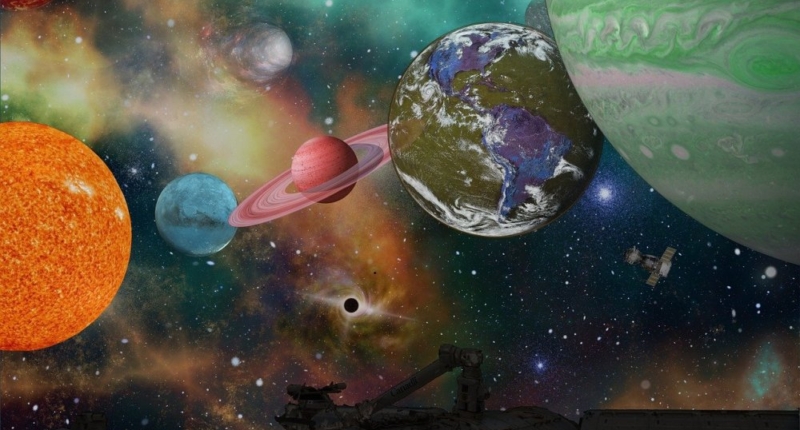Pluto, Ceres, Mars, Io, and Venus are all worlds that boast active volcanoes. Wright Mons, the largest cryovolcano in the solar system, is located on Pluto. Although it is still not fully understood, this feature’s discovery highlights the dynamic nature of the outer Solar System and the fascinating geological features that can be found on other icy worlds. Meanwhile, Ceres, the largest asteroid in the main asteroid belt, features the Ahuna Mons volcano, which was produced by cryovolcanism. Elysium Planitia, a volcanic region on Mars, is powered by a sub-surface mantle plume similar to those that drive volcanic hotspots on Earth. Io, the most volcanically active body in the Solar System, has over 400 active volcanoes on its surface. Finally, Venus has recently made the news with evidence for current volcanic activity.
Volcanic Activity Beyond Earth
Recent news about volcanic activity on Venus has made headlines, but other worlds beyond Earth also boast active volcanoes. Here are four such worlds in the Solar System.
Mars
While active volcanoes on Mars have not been directly observed, there are many signs of volcanism on the planet’s surface. The largest known volcano in the Solar System, Olympus Mons, dominates the Martian landscape. It stands at a towering 26km, is twice as high as Mount Everest, and has a base the size of Poland. The volcano is flanked by many solidified lava flows, some only a couple of million years old.
Olympus Mons is a basalt “shield volcano,” similar to those found on Earth, like Mauna Kea in Hawaii. Another volcanic region on Mars, Elysium Planitia, is believed to be active today, powered by a sub-surface mantle plume. This theory is supported by seismic data collected by NASA’s Insight lander spacecraft, which detected numerous “Mars quakes” emanating from this region.
Ceres
Ceres, the largest asteroid in the main asteroid belt, is a small world of just under 1,000km in diameter. In 2015, NASA’s Dawn mission visited Ceres and made an interesting discovery: Ahuna Mons, a volcano.
Io
Jupiter’s moon, Io, is the most volcanically active world in the Solar System. It has more than 400 active volcanoes and a landscape that is constantly reshaped by volcanic activity. The volcanic plumes on Io can reach up to 500km in height and are visible from Earth.
Enceladus
Saturn’s moon, Enceladus, is an icy world with a subsurface ocean that harbors hydrothermal vents. These vents, powered by heat from the moon’s interior, spew water and ice into space, creating a massive plume that extends hundreds of kilometers above the surface. This plume also contains gases and organic molecules, making Enceladus a potential target for the search for extraterrestrial life.
In conclusion, volcanic activity is not uncommon in our Solar System. Planetary bodies such as Mars, Ceres, Io, and Enceladus demonstrate the diverse ways in which volcanoes can form and contribute to the shaping of their respective worlds.
Cryovolcanism and Volcanism in the Solar System
The Solar System is home to a variety of worlds with unique geological features, including volcanoes. Here, we’ll explore two types of volcanoes found on Ceres and Io.
Cryovolcanism on Ceres
Most of Ceres’ surface is covered in impact craters, but Ahuna Mons stands out as a unique feature on the dwarf planet. This approximately 4km high mountain is the only cryovolcano, or icy volcano, known to exist near the Sun. The mechanism for its formation is believed to be cryovolcanism, where liquid salty water is ejected instead of lava. These salt-water eruptions are produced due to the pressure from Ceres’ icy surface, and as the water evaporates away under the vacuum of space, it leaves behind salt deposits.
Volcanism on Io
Io, the innermost large moon of Jupiter, is quite the tortured world. It is the most volcanically active body in the Solar System, with more than 400 active volcanoes on its surface. The energy for these volcanoes comes from tidal forces due to the proximity of the second nearest large Jovian moon, Europa, and the largest Jovian moon, Ganymede.
Io’s surface is a distinctive yellow-red colour due to vast deposits of sulfur, much of which has been erupted from the many active volcanoes. Some of the most spectacular volcanoes on Io erupt plumes of material hundreds of miles above the surface. This moon’s surface is constantly reshaped by volcanic activity and the powerful gravity of Jupiter and its moons.
Conclusion
These are just two examples of the diverse volcanism found in the Solar System. Cryovolcanism on Ceres and traditional volcanism on Io demonstrate the different ways in which volcanic activity can shape a celestial body. As we continue to explore the Solar System, we may discover even more unique geological features on other worlds.
Wright Mons: The Mystery Mountain of Pluto
Pluto, the largest known member of the Kuiper Belt, is an icy dwarf planet located in the distant outer Solar System. Despite its frigid conditions, Pluto is an active world with many intriguing features. In 2015, NASA’s New Horizons mission flew past Pluto and its moon Charon, providing us with fascinating information about this icy world.
One of the most remarkable features discovered on Pluto was Wright Mons, a large mountain standing over 4km high and about 150km across, with a distinctive large depression at the summit. The absence of recent meteorite impact craters on this feature suggests that it is young, geologically speaking.
Wright Mons is believed to be a cryovolcano, similar to those found on Saturn’s moon Titan and Ceres, but it is the largest such feature known in the Solar System. However, the true nature of this intriguing mountain is still not fully understood, and its formation remains a mystery.
Despite our limited knowledge, the discovery of Wright Mons on Pluto highlights the dynamic nature of the outer Solar System and the fascinating geological features waiting to be discovered on other icy worlds.
Don’t miss interesting posts on Famousbio










